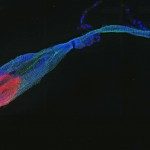Link to Pubmed [PMID] – 9233669
Mol. Biochem. Parasitol. 1997 Jul;87(1):1-11
Using oligonucleotides derived from Pf60.1, a member of the Plasmodium falciparum Pf60 multigene family, numerous fragments were amplified from genomic and cDNA from the 3D7 P. falciparum clone. DNA sequencing showed that the various fragments presented considerable diversity, indicating that the 3D7 repertoire contains at least 20 distinct versions of the region analysed. The various sequences aligned with either of two prototype sequences. Characteristic of the A-type was the presence of a 21 bp motif, present in variable copy number, as well as a sequence homologous to the Babesia sp. RAP-1 consensus. The B prototype sequence did not present such features and substantially differed from the A-type, due to accumulation of point mutations and numerous triplet deletions. Consistent with the marked differences between both sub-families, individual members from each sub-family did not cross-hybridise, produced distinct multiple band patterns on Southern blots and distinct chromosome profiles. Numerous hybrid sequences were observed. Interestingly, most var genes and var-related unspliced cDNAs described so far are of A/B hybrid type. These data suggest that the family has evolved by successive amplifications from two ancestral copies, with accumulation of mutations, as well as recombination and/or gene conversion events.

